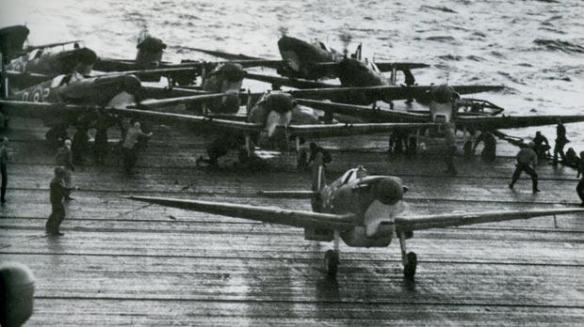Spitfires taking off from the USS Wasp on April 20, 1942, during Operation Calendar.
On the morning of 9 May, 64 Spitfires destined for Malta took off from the decks of the carriers USS Wasp and HMS Eagle and, this time, Malta was ready for them. The AOC decided that if the aircraft arrived in moderately serviceable condition and in daylight, it should be possible to re-arm and refuel them within ten minutes, thus avoiding a repetition of the damage inflicted following the previous delivery. Five ground crew were to be allocated to each aircraft pen. As soon as the long-range tanks were removed and the fighter refuelled and re-armed, it would take off, this lime with an experienced ‘Malta hand’ at the controls.
Enemy activity over Malta commenced at 0720, when a reconnaissance Ju88 and five Bf109Fs crossed the coast, only the AA guns engaging them. When another Ju88, five Cants, 16 Macchis and up to 45 Messerschmitts appeared two hours later, however, nine Hurricanes (six from Luqa and three from Hal Far) took off to provide some protection for the first batch of Spitfires, which were then imminently due. Two of the Hurricanes collided in mid-air in the mad scramble to get airborne although both were able to land safely. Neither Sgt Norm Vidler (BN362) nor the other pilot involved was injured. The Hurricanes were followed by six 603 Squadron Spitfires, both formations seeking to provide maximum cover for Takali. As the first of the new arrivals appeared they went in to land at once, the Hurricanes endeavouring to hold the enemy fighters at bay. As one Spitfire lowered its wheels and commenced its slow approach, a Bf109F raced towards it, Sqn Ldr Farnes of 229 Squadron immediately intercepted, turning violently with the Messerschmitt as it attempted to avoid his fire; he claimed some damage and succeeded in driving it away. In a letter to his parents, one of his pilots, Plt Off Tom Lawrence, later wrote:
‘I did not engage, but when I was coming into land I was strafed by Messerschmitts. On the point of landing, with wheels and flaps down, I was jumped by 109s. Controller called up other pilots to give me protection for I was helpless, but it was really too late, and the next thing I heard was the Controller let out a groan. Well, I thought, I have had it! But I managed to race along the end of the runway and turned the aircraft with my back to the sea (to take advantage of the armour plating. as I knew they would be coming from that direction) and stopped, with my head well down in the cockpit. There was a roar and a babble all round me, and I looked up and saw the Messerschmitt climbing for height. Well, I got out of that one alright:’
The 603 Squadron Spitfires enjoyed better success and claimed two Messerschmitts for one loss. Meanwhile, the initial batch of Spitfires had got down safely: a few were refuelled within four minutes, the remainder within seven, with pilots strapped in the cockpits ready to scramble. At 1055, eleven of the new aircraft took off, now flown by 249 Squadron pilots, and almost immediately encountered a formation of Messerschmitts. One of the enemy fighters was claimed shot down and two others probably so, but one Spitfire was lost with its pilot, Plt Off D’ Arcy Milburn, who had until recently been flying Hurricanes with 185 Squadron.
At 1115, Spitfires were again scrambled, a total of 31 taking to the air as more reinforcements approached the island. Most of the new arrivals were still waiting to land as an estimated 40 Messerschmitts appeared at 12.000 feet, shepherding a dozen Ju88s and five Cants. Their target was Hal Far, which soon disappeared under a cloud of dust and smoke. Two civilians and three soldiers were killed, while the airfield was rendered unserviceable for several hours. One Spitfire pilot, who had just landed, immediately tried to take off again to assist a comrade who was being attacked but struck the top of a dispersal pen, crashed and was killed. Only two of this latest batch of Spitfires failed to arrive. Throughout the rest of the day Axis forces returned repeatedly in an effort to catch the new Spitfires on the ground. At 1315, some 15 Ju88s and 18 Bfl09Fs attacked Hal Far and Takali, and were met by 24 Spitfires, six of which were flown by Hurricane pilots of 185 Squadron, as recalled by Plt Off Phil Wigley:
“Most of the pilots had never flown Spitfires before and it had been originally intended that they should not fly them immediately on operational flights. However, the few survivors of 185 were not prepared to accept this decision without protest, and an appeal to Air Vice-Marshal Lloyd soon reversed it – those without Spitfire experience had been shown the cockpit drills by Plt Off McKay, who had:’
In such desperate circumstances, it was an understandable decision to allow Malta experienced pilots the opportunity of flying the new machines into action. But it would ultimately prove to be a tragically unwise one. From this initial action, Plt Off Ron Noble returned to Takali slightly wounded and had to crash-land his Spitfire, which was written-off. The 185 Squadron pilots were airborne again at 1620 as Ju87s carried out attacks on Luqa and Grand Harbour, and although they gained some successes, Fit Sgt Gordon Tweedale was shot down and killed, his Spitfire crashing at Lija. Thus died one of Malta’s more successful Hurricane pilots. He had claimed six victories (of which two were shared) and three probables in a short period of time.
